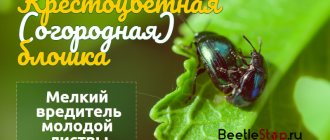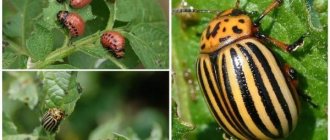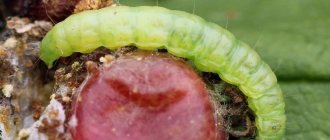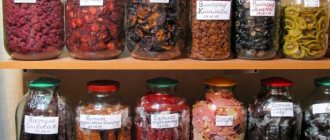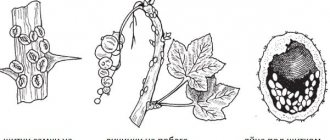Currants are one of the most popular fruit and berry crops throughout our country. Almost every gardener cultivates it.
For information on how to properly plant and grow currants on your site and about the best varieties, read the article “How to grow currants.”
This summer has been very hot, and the winter has been quite warm, so many pests have appeared in the gardens. Gardeners from different regions of the country complain that currants on their plots are suffering greatly from these uninvited guests.
Therefore, today we will talk about how to deal with currant pests, and how to determine who attacked your bushes, because many harmful insects not only damage all parts of the plant, but are also carriers of serious diseases from which the plants can die.
Scale insects - blackcurrant pests and how to combat them in spring (with photo)
Willow scale Chionaspis salicis L.
A small sucking insect, covered on top with a wide pear-shaped shield of light gray color, widened towards the rear. The female has a scutellum 2.4 mm long, 1.4 mm wide, the male has a smaller one, 1-1.3 mm long, 0.4-0.5 mm wide. The body of the female is orange, the wandering larvae are bright red, the eggs are violet-red. The eggs overwinter under the shields of females, from 40 to 80 eggs under each. These pests of black currant emerge in the spring during flowering: bright red wandering larvae hatch, crawl and stick to the bark. Therefore, the fight against currant pests in the spring begins with the elimination of damaged parts of the bush.
Kidney mite
If in the spring large swollen buds are found on a currant or gooseberry bush, similar to small cabbage heads, most likely a bud mite lives in them. When the larva becomes crowded in a bud, it moves to another and thus damages a large number of berry buds. The tick is also dangerous because it can carry the terry virus.
Control measures
In early May, during budding, “suspicious” buds must be plucked out. Before flowering, when mites are most vulnerable, the bushes are sprayed with an insecticide (Aliot, Tanrek, Fufanon-Nova, etc.).
Furrow mower: spring treatment of blackcurrant bushes from pests
Sulcata mower Otiorrhynchus sulcatus Fabr.
Weevil beetle 8-10 mm long, pitch-black, with a metallic sheen, hips with a tooth. The rostrum is clearly expanded at the apex; it has a deep and wide longitudinal groove. Spring treatment of currants against pests of this type includes collecting and burning all plant residues. Then the treatment of currant bushes from pests is carried out by spraying them with insecticides.
The larva is small, white, legless, cylindrical, somewhat curved, with a brown head. The larvae feed and develop in the roots of plants, making passages in the wood. The beetles damage the leaves, eating the edges in small areas, shallowly, in a patterned manner, and also damage the buds. The furrow mower often damages currants, raspberries, grapes, apricots and deciduous shrubs and trees.
Control measures. Preventive treatment of black currants against pests after flowering with one of the drugs: fufanon, kemifos, actellik.
Preventive measures
♦ Effective boiling water. Hot water destroys the larvae of various currant pests that live and overwinter on the shoots of the bush.
At the same time, the bushes themselves do not suffer from dousing, but only become stronger. When carrying out the procedure, adhere to the following rules:
- Do not use 100% boiling water. Let the water cool a little.
- Before the event, tie the branches of the plant together.
- You can pour currants only in their dormant state.
Treatment of currants against pests is carried out during a period when it is already warmer, but there is no green haze on the bushes.
You can also water the plants in winter, when the bushes are free of leaves.
♦ Handmade. One effective method is manual collection of harmful caterpillars.
In the fall, dig up the soil and hill each bush to a height of 10-12 cm with soil to a radius of up to 70 cm.
Pupae overwintering under plant debris will end up at destructive depths - they will be destroyed by the winter cold.
The layer of soil can be removed 2 weeks after the end of flowering of the bush.
♦ Competent care. Do not cut cuttings from plants affected by currant pests; carefully handle and disinfect your working tools (especially after pruning the bushes).
Buy only high-quality seedlings from professional nurseries.
- In early spring, carry out thorough sanitary pruning of plants. To avoid the spread of parasites along with planting material, prepare cuttings before the insects become active after wintering.
Monitor the condition of your plantings! Remove old stumps, dry shoots, do not leave plant debris or leaves under the bushes (burn them in a timely manner).
Every autumn, carry out a general cleaning of the garden. Remove all weeds, dig up the soil well, and in the spring collect all the remaining grass and dry leaves.
♦ Down with the ants. The fight against aphids of all types must begin with the destruction of ant colonies.
Try to find an anthill and fill it with boiling water in the spring.
After the ants disappear, you can exterminate the aphids themselves. It hides inside the kidneys. The eyes have an enlarged, rounded shape.
All such ovaries must be collected and burned. You also need to regularly remove excess growth.
Be sure to clean the bark if it begins to peel off - there may be oviposition there.
♦ Beneficial insects. The spread of many currant pests is resisted by such beneficial entomophagous insects as aphelinus, aphidimiza gall midge, trichogramma and others.
To attract them, aromatic honey-bearing herbs (oregano, rosemary, calendula, cosmos, mallow, marigold) should be planted on the site.
Entomophages are also attracted to other plants (parsley, clover, sunflower, buckwheat, dill, celery).
- Ladybugs, hoverflies, and lacewings are good for combating many types of parasites. They will appear if there are chamomile, tansy, coltsfoot, dandelions, evergreen shrubs, and ferns in the garden.
Take your time to rid your garden of weeds. We are talking about a swan. It should be left near the currants at least 1-2 bushes.
Quinoa is an excellent treat for some types of harmful insects. The weed is capable of taking the blow, and as soon as you see that the plant is affected by currant pests, destroy it.
Spraying currants against pests
It is necessary to spray currants against pests such as sawflies of various types. How to do this - read on.
Yellow blackcurrant sawfly Nematus leucotrochus Hart.
The insect is reddish-yellow in color, 7-8 mm long. The larva is bluish-green, has 10 pairs of legs, the head and chest legs are black, the rest are yellow with dark markings. The eggs are elongated, milky white, 2-3 days before the larvae hatch, two black dots appear at the narrowed end. The larvae overwinter in the soil in dense cobweb cocoons and pupate there in early spring. Soon the adult insects emerge and almost immediately the females lay eggs, placing them one at a time on the underside of the leaf. After 6-8 days, the larvae emerge, eat holes in the leaves, and then eat them around the edges. The development and feeding of the larvae lasts 13-14 days, after which they go into the soil and pupate. One generation develops in 25-30 days and 3-4 generations can appear in a year.
Control measures. Preventive spraying of bushes after flowering with one of the following preparations: fufanon, kemifos, actellik, fitoverm, kinmiks, spark, Inta-Vir. If there are a large number of larvae in the summer, spraying with the same preparations is carried out after picking the berries. Single larvae are collected and destroyed.
Aphid
The red gall aphid is a common pest of red currants; less commonly, this species harms the black variety. Signs of damage are red swellings on young leaves that dry out and fall off.
Black currants are also affected by gooseberry aphids. Signs of damage: leaves are affected, curling into a ball. Damaged shoots become bent and stop growing normally.
You can get rid of aphids by tearing off the leaves infested with them, if there are only a few of them. Treatments with infusions of yarrow, tobacco, chamomile, dandelion, mustard (with the addition of soap), and planting tomatoes, garlic or onions near currants will help.
For prevention, insecticides should be used: when the buds open - Iskra DE (10 g per 10 liters of water), consumption 1.5 liters per bush, after flowering - Karbofos (60 g per 10 liters of water). Destroy ants, destroy anthills.
Moth caterpillars on currants: how to fight
Currant moth Incurvaria capitella Cl.
A small moth with a wingspan of 13-17 mm. The head is yellowish, the wings are narrow and long. The fore wings are yellow-brown with pale yellow spots of varying sizes, the hind wings are plain gray.
Caterpillars on currants are 7-8 mm long, the head and chest shield are black. With each age, the caterpillars change color. When they are young they are red, at the third instar they become greenish-yellow, and at the fourth instar they become grey-green.
Younger caterpillars overwinter in white cobweb cocoons under the bark of cuttings of old shoots. In early spring, before the buds open, the caterpillars emerge from the cocoons, bite into the swollen buds and feed on their tissues. Each caterpillar damages several buds. Having finished feeding, the caterpillars descend to the ground and pupate in the top layer of soil. Pupation and development of pupae occurs during currant flowering. Affected currant buds dry out. After a few days, the butterflies emerge and after fertilization, the females lay eggs in small ovaries of the berries. The hatched caterpillars live and feed inside the berries for several days, then descend to the base of the bush, crawl under the drying bark, weave cocoons and enter diapause until the spring of next year. The moth damages black, red and white currants, and in large numbers destroys up to 50% of the buds, which sharply reduces the yield of berries and the normal development of bushes.
Control measures. Before fighting caterpillars on currants, you need to carry out preventive spraying of the bushes in the spring, before buds open, with one of the drugs: fufanon, kemifos, actellik.
Pruning and burning dried branches, collecting damaged, prematurely colored berries.
Currant diseases: description with photographs and methods of treatment
Currants are susceptible to various diseases, mainly caused by fungal microorganisms. Sources of infection can be the soil, other plants - if you prune the garden with the same pruning shears without treatment, the disease will quickly spread to all plantings. Microorganism spores fly through the air. If there are cuts or damage on the bush, the fungus penetrates the stems and leaves and begins to actively multiply. There are many diseases that affect currants.
Columnar rust
This is a fungal disease that mainly affects black currants, less often red currants and gooseberries. Externally, the disease is easy to recognize. Yellow spots appear on the leaves, and spore-bearing columns of rust, similar to hairs, are visible on their insides. It is under the leaf blades that the fungus spends the winter.
Columnar rust on leaves is very dangerous. The disease not only reduces yield, but also negatively affects winter hardiness. Affected bushes often die in winter, unable to withstand frost. Some dry out even without waiting for the colder weather.
Fighting glassworm caterpillars on currants
Currant glassberry Synanthedon tipuliformis Cl.
A small black butterfly with a bluish tint with narrow transparent wings. The long thin abdomen has yellow transverse stripes, and at the end of the abdomen there is a brush of black hairs. The fight against caterpillars on currants begins with the destruction of oviposition of adult individuals.
The outer edge of the fore wing has brownish-yellow scales; there is a blue border near it; in the middle of the wing there is a transverse stripe of blue scales. The hind wings are transparent, with gray fringe. The caterpillar is 20 mm long, white, has 8 pairs of legs, the head and chest shield are brownish-brown, shiny. The pupa is brown-yellow. The eggs are oval-shaped, yellowish-white. The caterpillars overwinter inside damaged currant branches and pupate there in May. At the end of May-June, butterflies emerge through holes gnawed by caterpillars before pupation. The flight of the glassberry begins 10-15 days after the end of currant flowering. After fertilization, females lay 40-60 eggs, placing them one at a time on branches and buds. After 9-15 days, the caterpillars hatch, bite into the shoots and feed on their core. Damaged branches stop growing, wither and dry out. Glassweed damages currants and gooseberries.
Currant glass
This is a butterfly, somewhat similar to a wasp, with transparent wings, which have a dark border. Caterpillars live inside the stems and overwinter and pupate in them. Glass butterflies fly out in June and immediately begin laying eggs near the buds.
The larvae penetrate through them into the shoots, feed on their core, going down the stems, which is why they become fragile, break easily, and a black core is found inside.
Young shoots wither and dry out in the spring. Glassworts also settle in fruits, eat them up, which is why they quickly ripen, but become unsuitable for food.
To get rid of glass from currants:
- carry out pruning of shoots with larvae and standard autumn pruning;
- treated with Fitoverm (2 ml of the drug per 1 liter of water), Lepidocide (50 ml per 10 liters of water), Kinmiks (1 ampoule per 10 liters of water), Iskra-M (1 tablet per 10 liters of water), Fufanon (10 liters of water 10 ml).
How to treat currants against moth caterpillars
Hairy moth Phigalia pedaria F.
A butterfly, the female of which has only the rudiments of wings. The head and back are light gray, the abdomen is red-brown. The wingspan of the male is 40-42 mm. The fore wings are wide, greenish-gray with dark pollination and unclear transverse lines, the hind wings are light and fringed. The caterpillar is greenish-brown or yellow-brown, with a yellow chest band, yellow warts and dark longitudinal lines. The pupa is red-brown in color. The pupae overwinter in the soil. In early spring, butterflies emerge and after fertilization, the females lay eggs on the budding leaves. The caterpillars hatch in early May and feed on the leaves of plums, thorns, deciduous trees and shrubs until July. Hairy moth is quite common on currants.
Control measures. Before treating currants against caterpillars, you need to carry out preventive spraying of shrubs and trees in the garden before flowering and after flowering with one of the preparations: fufanon, kemifos. actellik, kinmiks, spark, Inta-Vir.
Shchitovka
A sign of damage is the gradual drying out of the leaves of the plant. If you examine them, you will find small brown, motionless insects. Scale insects on currants are destroyed in the spring with Nitrafen, treatment with a mixture of water, soap and kerosene (40 g and 10 drops per 10 liters of water, respectively).
You can also use biological preparations: Fitoverm, Iskra-bio, Agravertin.
Cutworm - black caterpillar on currants
Warlike scoop
A moth with a wingspan of 40 mm. The fore wings are red-brown, ending in sharp teeth, the hind wings are brownish-gray, with a light fringe. The caterpillar is 40 mm long and 7 mm thick, black, with whitish spots on the sides of the first, second, fourth and tenth abdominal segments, and three longitudinal light lines on the back. The head is black-brown, the pupa is yellow-brown. Butterflies overwinter in a light earthen cocoon after pupation.
From March at a temperature of +2 °C until May, butterflies fly. Females lay eggs on buds and budding leaves. Hatched black caterpillars on currants live alone, gnaw leaves, and when they are older, eat them whole, leaving one vein. The cutworm damages pome and stone fruit crops, deciduous trees and shrubs. When in large numbers, it causes great damage to young trees and shrubs in nurseries, completely eating away the leaves.
Control measures are the same as against the hairy moth.
How to get rid of downy back caterpillars on currants
Pink downy back or pink armyworm Thyatira batis L.
A moth with a wingspan of 35-38 mm. The front wings are oblong-triangular, dark brown or brown, on each wing there are 5 large pinkish-white round spots with a brownish center. The hind wings are lighter, brownish-gray, with a blurred transverse stripe and light fringe. The wings fold along the body.
The caterpillar is 35-36 mm long, has 8 pairs of legs, is naked, pinkish-brown or rusty-brown. On the second segment of the body there is a tubercle in the form of a collar with two points, directed forward. There are tubercles on abdominal segments 2-6, and there are 5 projections on the fifth and ninth segments. The pupa is brown, 16-18 mm long. The caterpillars feed on the leaves of raspberries, blackberries, stone fruits, and less often currants. When at rest they sit on the upper side of the leaves, resembling bird droppings. The caterpillars overwinter, in May they come to the surface and feed on young growing leaves, then they pupate, and in July the females lay eggs on the leaves. The hatched caterpillars feed in August-September, after which they leave for the winter.
Control measures. Before getting rid of caterpillars on currants, it is necessary to carry out preventive spraying of the bushes after flowering with one of the drugs: fufanon, kemifos, actellik, kinmiks, spark, Inta-Vir. If there are a large number of caterpillars, spray with the same preparations after picking the berries.
Watch the common currant pests and the fight against them in the video, which shows all the agricultural technology of this complex process:
- Author: Tatyana
Rate this article:
- 5
- 4
- 3
- 2
- 1
(19 votes, average: 3.5 out of 5)
Share with your friends!
Pests in the garden
Cultivated plants always attract all kinds of worms, caterpillars, bugs, and butterflies. Weeds are luckier in this regard: they do not attract interest from aphids and caterpillars. Therefore, gardeners, already with the first warm days of spring, begin preparing the garden for the invasion of uninvited guests. Experienced farmers count more than seventy species of pests. We will look at the most common ones among them.
Common currant pests:
- currant bud mite;
- bud moth;
- willow scale;
- redcurrant aphid;
- spider mite;
- currant gall midges;
- currant borer;
- glass of currant;
- gooseberry moth;
- shoot aphid;
- gooseberry moth.
The best way to combat pests is through preventive measures, destroying the larvae.
Ticks are one of the most dangerous parasites that can destroy standing crops. On their legs, insects carry diseases that cause additional harm to crop plants. Thus, the currant bud mite spreads terry and mycoplasmosis. If the plant is not saved from a mite attack, it dies.
Currant bud mite
The insect loves blackcurrant varieties and gooseberries most of all. The mite parasitizes the buds of plants, as it does not tolerate high temperatures and humidity. The mite enters the area along with the seedlings and then spreads. How to understand that a bush is attacked by ticks? After flowering ends, the buds begin to dry out and fall off. At this crucial moment, the parasites can be destroyed, because they are forced to come to the surface in search of new fresh growth.
Note! The bud mite infects currants with an incurable virus (mosaic, terry), which completely destroys the bush.
You can notice infected branches even in winter. If you notice that some buds are larger in size, it means that a bud mite is overwintering there. In the spring, infected branches also make themselves felt: the shape of the leaves is deformed, the shoots grow unevenly, and flower clusters are not formed everywhere.
In summer, infected shrubs look very unsightly. They can be seen by sparse berry clusters and deformed (twisted) branches. On the bush you can see dried berries that could not ripen. In autumn, the eyes of the buds become swollen, their shape and size vary.
Security measures:
- The swollen buds are immediately cut off along with part of the branch and burned with fire. As a last resort, it is necessary to prune the entire bush, leaving only small cuttings above the soil surface.
- Spraying with garlic infusion will help eliminate the harmful parasite (the infusion is made from a bucket of water and 100 g of garlic).
- To prevent tick activity, garlic or onions are planted next to the bush.
- The affected bush is generously sprayed with a sulfur-containing infusion.
- In the fall, after the leaves have fallen or in the spring after the snow has melted, the shrubs are treated with boiling water (80-90 degrees). This helps kill pests.
- After harvesting, the bushes are sprayed with acaricides. Since these products are toxic, they are used only in late autumn.
If this care regimen does not suit you, purchase mite-resistant currant varieties. Breeders have bred several species of plants in whose buds the bud mite does not nest (Black Pearl, Nightingale Night).
Willow scale
The body of these insect pests is covered with a shell like a shield. Parasites feed on currant juices, so they are located on the stems. The affected plant stems appear to be covered with white cobwebs or small white cocoons. In late autumn, pests move under the bark of branches for the winter.
Scale insects greatly weaken the plant, taking away its vitality. It is not easy to remove this parasite; you have to manually scrape off the cocoons from the branches (then the bush is treated with Actellik emulsion). Only larvae are susceptible to the action of agrochemicals; for this, the drug Nitrofen is used after the snow melts.
Note! If the stems and branches of the currant are completely covered with scale insects, the bush must be cut off at the root. Branches and stems should be burned immediately in a fire.
If you are afraid to use chemicals, you can use traditional methods of getting rid of scale insects. To do this, use infusions of celandine and coltsfoot herbs. Onion infusion is also used to exterminate parasites. Some gardeners use an aqueous solution of soap and kerosene to treat the twigs. 40 g of grated laundry soap and 10 drops of kerosene are diluted in a bucket of water.
Bud moth
The pest is a small butterfly, whose eggs overwinter under the currant bark. In the spring, the pupae begin to actively eat currant buds, causing irreparable damage. When flowering occurs, the caterpillars turn into butterflies. Butterflies lay eggs directly in the berries. The moth prefers white or red currants, but sometimes eats black ones.
To get rid of moths, the bush is treated with infusion of shag, mustard or onion. Of the chemicals used, Karbofos. If you notice that the bark is coming off on some branches, they should be immediately cut off at the root and burned. It is better to light the fire away from the garden. Make it a rule to always burn fallen leaves of bushes and fruit trees.
Redcurrant aphid
The parasite is tiny in size - no more than 7 mm. Aphids feed on the juices of young shoots, destroying new shoots. The eggs of the parasite successfully overwinter on the twigs, and with the arrival of warmer weather, larvae form from them. In areas where aphids are active, the leaves curl, change color, and wither.
Ants are very fond of aphids (they like the waste products of these pests), so when these insects appear in the garden, you need to carefully inspect the garden plants. Ants are also a means of transport for moving aphids to new currant branches. Aphids also love to eat the shoots of rose bushes.
Currant gall midge
These pests resemble small mosquitoes that love to feast on the juices of gooseberries and black currants. They were called gall midges due to the formation of swellings (galls) on the tissues of the bush. Gall midges do not isolate individual parts of the bush, but spoil everything: stems, flowers, leaves. Pest larvae overwinter in the soil under currant bushes and move to the trunk with the onset of warm weather.
To combat gall midges, they use spraying with insecticides (in early spring), cutting out diseased shoots without forming a stump (so that gall midges do not lay eggs in it), and deep digging of the soil around the bushes before winter.
Spider mite
This is a dangerous parasite that reproduces on weeds, but destroys cultivated currants. The tick overwinters in the upper layers of the soil or in last year's fallen leaves. That is why it is important to burn all the foliage under the bushes and trees in the garden, and dig up the soil in the projection of the crown to the depth of a shovel. This must be done in order to deprive parasites and pests of a cozy wintering place.
In early spring, spider mites move to currant leaves and spin webs. As a result of its activity, the shrub loses its leaf cover, which negatively affects photosynthesis and plant development.
Fighting methods:
- regular cleaning of weeds on the site;
- burning fallen leaves in autumn;
- deep digging of the soil around the bushes;
- the proximity of garlic and onions;
- the use of chemical and natural means for spraying shrubs.
Spider mites harm not only currants, but also strawberries and cucumbers. You need to be prepared for his appearance on the site.
Currant borer
This pest can cause great damage in the garden, destroying a valuable currant crop. The larvae of the borer develop inside the stems and branches of currants, completely eating away their core. As a result, the plant dries out and dies. All dried branches must be removed and burned in a timely manner, since the borer can successfully overwinter in them. Next year, this parasite will expand its habitat and move to healthy bushes.
The female lays her eggs on currant branches, fixing them with an adhesive liquid. The larvae hatching from the eggs immediately move inside the branches and begin their destructive activities.
Fighting methods:
- timely removal of dried branches;
- treatment of shrubs with calcium arsenic acid and French greens.
Glassware
The pest resembles a butterfly with small transparent wings, the larvae of which live inside the wood of the bush. Glasswort, like the currant borer, feeds on wood tissue, as a result of which the branches simply dry out and cannot bear fruit. These butterflies are very prolific, they can lay up to 70 eggs at a time. Masonry is made in cracks in the trunk and shoots of currants. The larvae stay inside the branches of the bush all summer and winter, eating away at the core. The following spring they leave their shelter to develop into pupae and then become butterflies.
Fighting methods:
- remove dried branches;
- remove weeds from the site;
- spraying bushes with biological and chemical preparations that destroy this type of parasite.
It is important to carry out high-quality pruning of the affected branches directly to the root. The glasswort does not settle in the roots; it feeds only on the soft core of the branches. When cutting branches, you can notice voids instead of the core: this is the work of glass.
Gooseberry moth
This is a very dangerous insect for currants. Moth butterflies are capable of destroying currant bushes, as they lay hundreds of eggs, from which voracious caterpillars emerge. The caterpillars are clearly visible on the bush, as they have a bright green skin color. They feed on berries, which then rot and become covered with a kind of cobweb. The parasites overwinter in the form of a pupa under a currant bush; in the spring, when the weather gets warmer, they turn into butterflies and immediately begin to lay eggs.
Fighting methods:
- deep autumn digging around the bushes;
- mulching the soil around the bushes;
- treating bushes with infusion of mustard and ash;
- treatment with chemicals;
- destruction of caterpillars and rotten berries.
A good method of combating the moth is to cover the soil under the bush with a layer of film or paper. The pupae will not be able to get out and will die.
Gooseberry shoot aphid
This pest attacks young currant leaves, causing serious damage to the crop. Leaves affected by aphids bend inward, lose their life-giving juices, and then dry out. In summer, shoot aphids acquire wings and fly throughout the garden. Females lay eggs near the shoot buds, where they successfully overwinter. In the spring, when the plant awakens, larvae form from the eggs and begin to eat the leaves.
Fighting methods:
- treating the plant with a solution of laundry soap (30-40 g of soap shavings per bucket of water);
- treatment with chemicals before the bud break stage;
- spraying bushes with infusions of plants - potato tops, marigolds, coltsfoot.
You can also plant flowers next to currant bushes that attract insects. Some insects love to feast on aphids.
Gooseberry moth
These voracious caterpillars actively eat currant leaves. These are large individuals, reaching a length of up to four centimeters. They prepare for wintering in a special way: they entwine themselves with a web (like a cocoon) and fall to the ground along with the leaves. They overwinter in the upper layers of soil or in fallen leaves. In the spring, when the weather gets warmer, the caterpillars crawl out of the cocoon and begin to actively eat young leaves and shoots. They then turn into brightly colored butterflies, which lay eggs on the inside of the currant leaves.
Fighting methods:
- deep digging of the soil before winter;
- treating the soil around the bush with urea;
- collecting caterpillars from bushes in mid-July;
- treating bushes with chemicals.
It is relatively easy to detect this parasite, you just need to take the time.



